山西省吕梁市英杰中学2014年高考英语二轮复习教学案:定冠词the的用法
文档属性
| 名称 | 山西省吕梁市英杰中学2014年高考英语二轮复习教学案:定冠词the的用法 | 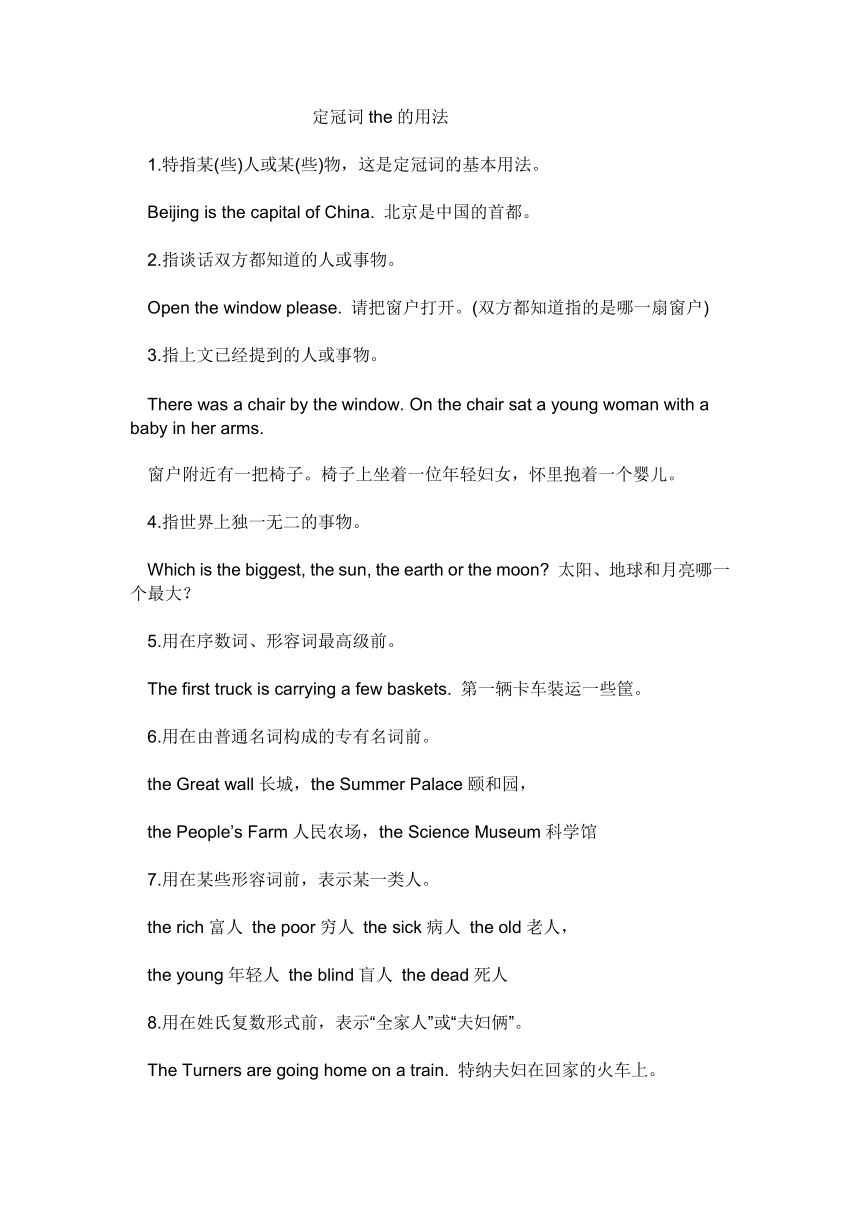 | |
| 格式 | zip | ||
| 文件大小 | 45.1KB | ||
| 资源类型 | 教案 | ||
| 版本资源 | 通用版 | ||
| 科目 | 英语 | ||
| 更新时间 | 2014-03-03 19:11:32 | ||
图片预览

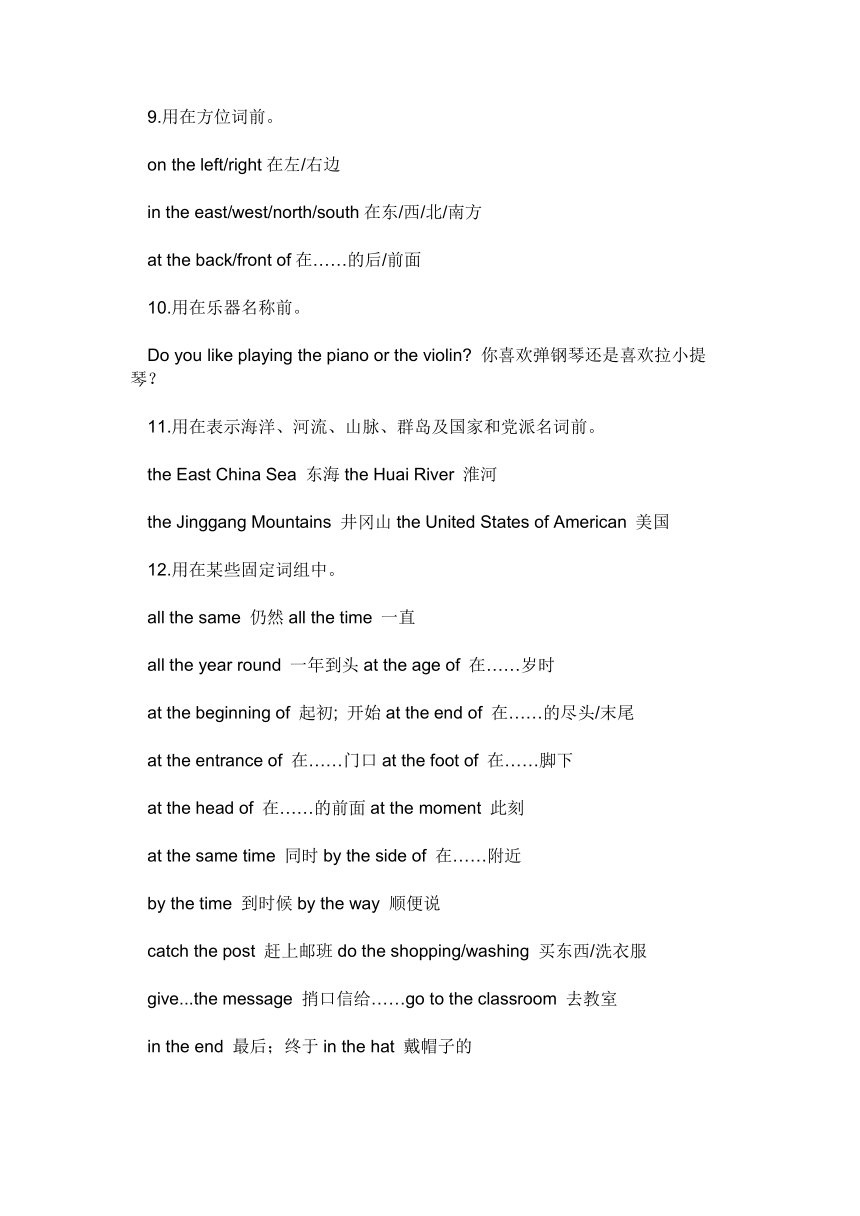
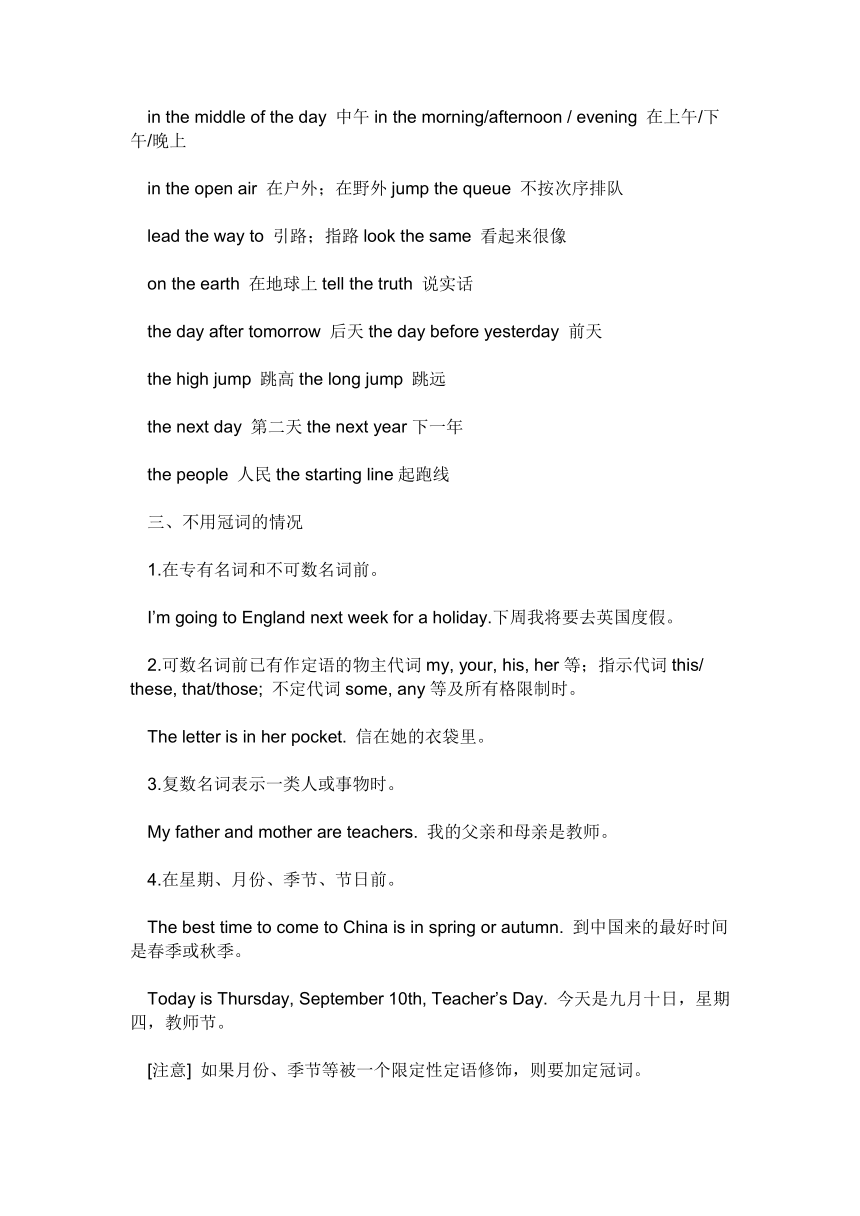
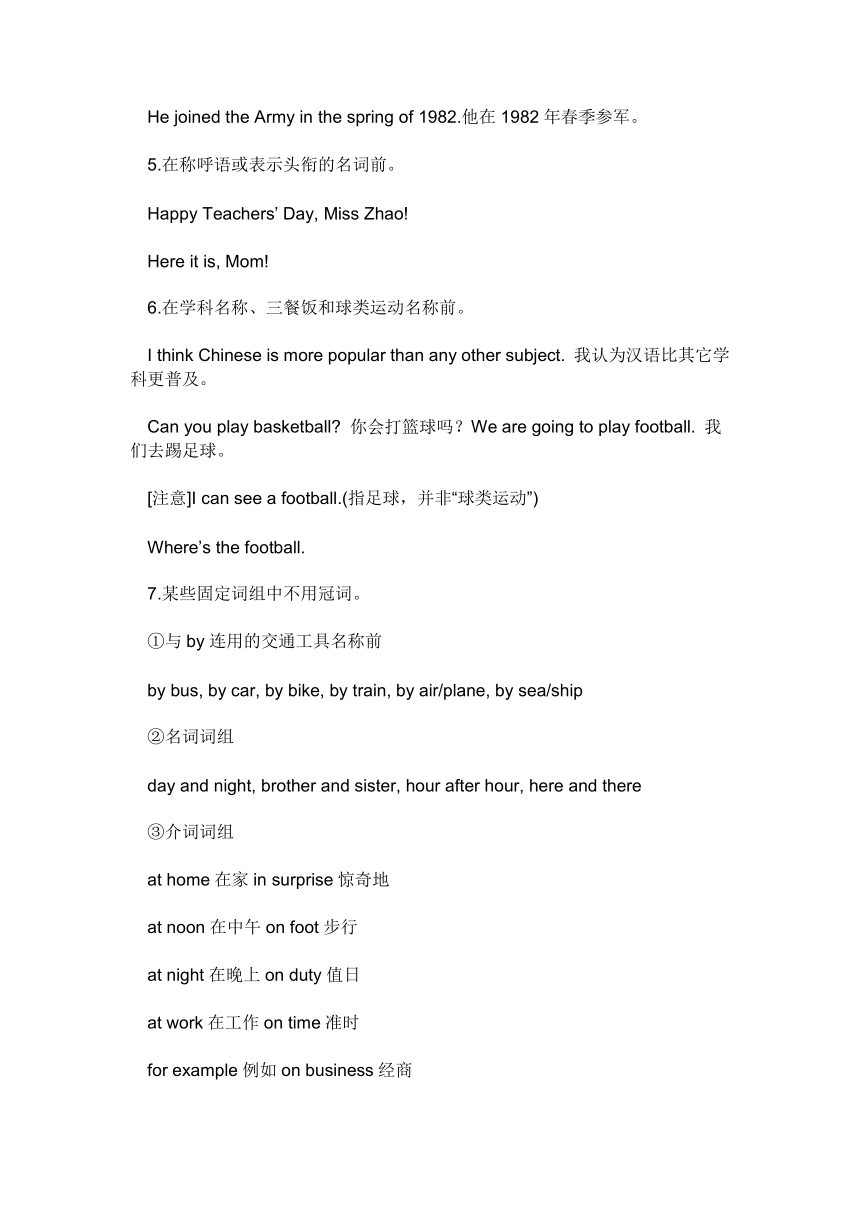
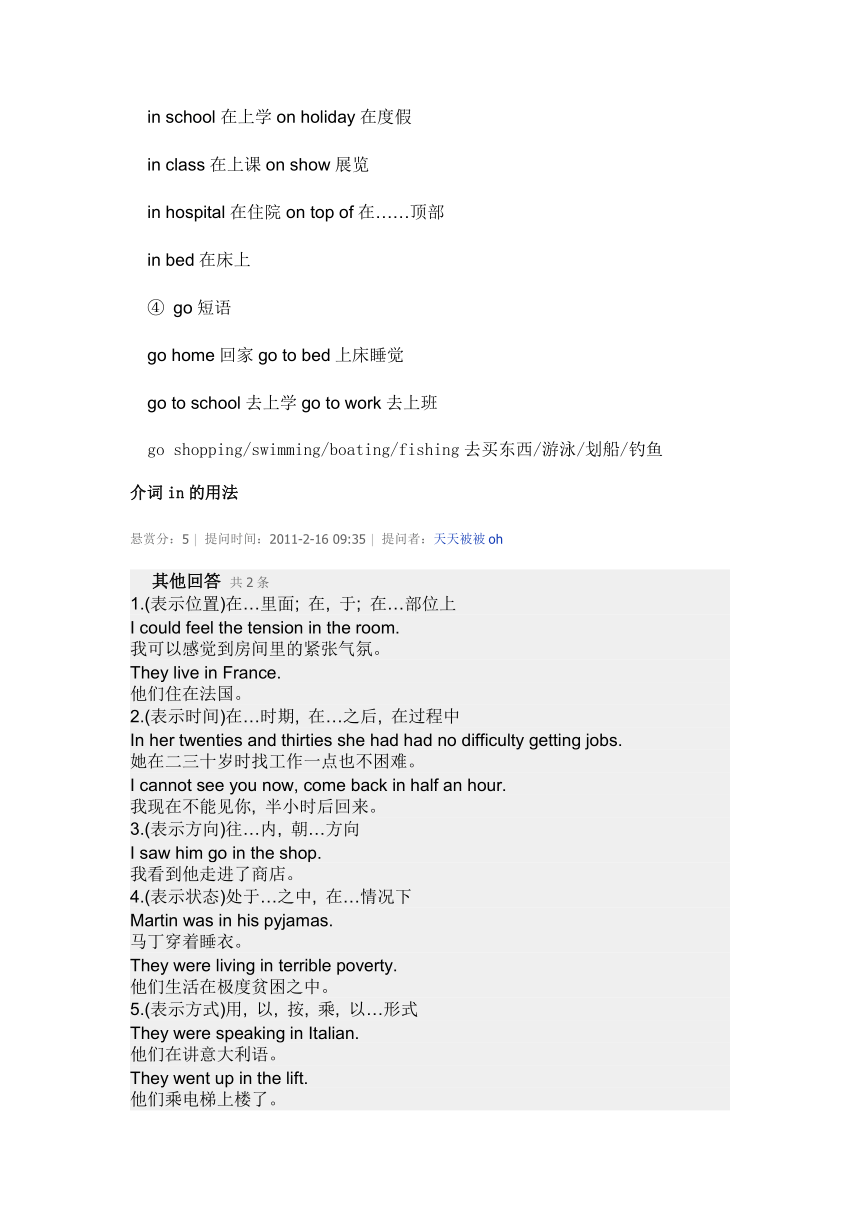
文档简介
定冠词the的用法
1.特指某(些)人或某(些)物,这是定冠词的基本用法。
Beijing is the capital of China. 北京是中国的首都。
2.指谈话双方都知道的人或事物。
Open the window please. 请把窗户打开。(双方都知道指的是哪一扇窗户)
3.指上文已经提到的人或事物。
There was a chair by the window. On the chair sat a young woman with a baby in her arms.
窗户附近有一把椅子。椅子上坐着一位年轻妇女,怀里抱着一个婴儿。
4.指世界上独一无二的事物。
Which is the biggest, the sun, the earth or the moon 太阳、地球和月亮哪一个最大?
5.用在序数词、形容词最高级前。
The first truck is carrying a few baskets. 第一辆卡车装运一些筐。
6.用在由普通名词构成的专有名词前。
the Great wall长城,the Summer Palace颐和园,
the People’s Farm人民农场,the Science Museum科学馆
7.用在某些形容词前,表示某一类人。
the rich富人 the poor穷人 the sick病人 the old老人,
the young年轻人 the blind盲人 the dead死人
8.用在姓氏复数形式前,表示“全家人”或“夫妇俩”。
The Turners are going home on a train. 特纳夫妇在回家的火车上。
9.用在方位词前。
on the left/right在左/右边
in the east/west/north/south在东/西/北/南方
at the back/front of在……的后/前面
10.用在乐器名称前。
Do you like playing the piano or the violin 你喜欢弹钢琴还是喜欢拉小提琴?
11.用在表示海洋、河流、山脉、群岛及国家和党派名词前。
the East China Sea 东海the Huai River 淮河
the Jinggang Mountains 井冈山the United States of American 美国
12.用在某些固定词组中。
all the same 仍然all the time 一直
all the year round 一年到头at the age of 在……岁时
at the beginning of 起初; 开始at the end of 在……的尽头/末尾
at the entrance of 在……门口at the foot of 在……脚下
at the head of 在……的前面at the moment 此刻
at the same time 同时by the side of 在……附近
by the time 到时候by the way 顺便说
catch the post 赶上邮班do the shopping/washing 买东西/洗衣服
give...the message 捎口信给……go to the classroom 去教室
in the end 最后;终于in the hat 戴帽子的
in the middle of the day 中午in the morning/afternoon / evening 在上午/下午/晚上
in the open air 在户外;在野外jump the queue 不按次序排队
lead the way to 引路;指路look the same 看起来很像
on the earth 在地球上tell the truth 说实话
the day after tomorrow 后天the day before yesterday 前天
the high jump 跳高the long jump 跳远
the next day 第二天the next year下一年
the people 人民the starting line起跑线
三、不用冠词的情况
1.在专有名词和不可数名词前。
I’m going to England next week for a holiday.下周我将要去英国度假。
2.可数名词前已有作定语的物主代词my, your, his, her等;指示代词this/ these, that/those; 不定代词some, any等及所有格限制时。
The letter is in her pocket. 信在她的衣袋里。
3.复数名词表示一类人或事物时。
My father and mother are teachers. 我的父亲和母亲是教师。
4.在星期、月份、季节、节日前。
The best time to come to China is in spring or autumn. 到中国来的最好时间是春季或秋季。
Today is Thursday, September 10th, Teacher’s Day. 今天是九月十日,星期四,教师节。
[注意] 如果月份、季节等被一个限定性定语修饰,则要加定冠词。
He joined the Army in the spring of 1982.他在1982年春季参军。
5.在称呼语或表示头衔的名词前。
Happy Teachers’ Day, Miss Zhao!
Here it is, Mom!
6.在学科名称、三餐饭和球类运动名称前。
I think Chinese is more popular than any other subject. 我认为汉语比其它学科更普及。
Can you play basketball 你会打篮球吗?We are going to play football. 我们去踢足球。
[注意]I can see a football.(指足球,并非“球类运动”)
Where’s the football.
7.某些固定词组中不用冠词。
①与by连用的交通工具名称前
by bus, by car, by bike, by train, by air/plane, by sea/ship
②名词词组
day and night, brother and sister, hour after hour, here and there
③介词词组
at home在家in surprise惊奇地
at noon在中午on foot步行
at night在晚上on duty值日
at work在工作on time准时
for example例如on business经商
in school在上学on holiday在度假
in class在上课on show展览
in hospital在住院on top of在……顶部
in bed在床上
④ go短语
go home回家go to bed上床睡觉
go to school去上学go to work去上班
go shopping/swimming/boating/fishing去买东西/游泳/划船/钓鱼
介词in的用法
悬赏分:5 | 提问时间:2011-2-16 09:35 | 提问者:天天被被oh
其他回答 共2条
1.(表示位置)在…里面; 在, 于; 在…部位上
I could feel the tension in the room.
我可以感觉到房间里的紧张气氛。
They live in France.
他们住在法国。
2.(表示时间)在…时期, 在…之后, 在过程中
In her twenties and thirties she had had no difficulty getting jobs.
她在二三十岁时找工作一点也不困难。
I cannot see you now, come back in half an hour.
我现在不能见你, 半小时后回来。
3.(表示方向)往…内, 朝…方向
I saw him go in the shop.
我看到他走进了商店。
4.(表示状态)处于…之中, 在…情况下
Martin was in his pyjamas.
马丁穿着睡衣。
They were living in terrible poverty.
他们生活在极度贫困之中。
5.(表示方式)用, 以, 按, 乘, 以…形式
They were speaking in Italian.
他们在讲意大利语。
They went up in the lift.
他们乘电梯上楼了。
6.(表示原因)由于, 为了
He went in fear of his life.
他为自己的性命担忧, 所以走了。
7.(表示领域, 范围)在…以内
It is not in my power to do that.
做那事非我力所能及。
8.(表示结果)当做, 作为
What did you give him in return
你给他什么作为报答呢
9.(表示目的)为了
They set off in search of the lost child.
他们出发去寻找走失的孩子。
10.[表示职业、活动等]从事于,参加
11.[表示数量、程度、比例]按,以;从…中
12.[表示品质、能力等]在…之中;在…身上
I don't think he had it in him.
我认为他没这个本事。
回答者: pwx1230 ( http: / / www.21cnjy.com" \l "2" \o "欢迎登陆21世纪教育网" \t "_blank ) | 二级 | 2011-2-16 09:38
1.(表示位置)在…里面; 在, 于; 在…部位上
2.(表示时间)在…时期, 在…之后, 在过程中
3.(表示方向)往…内, 朝…方向
4.(表示状态)处于…之中, 在…情况下
5.(表示方式)用, 以, 按, 乘, 以…形式
6.(表示原因)由于, 为了
7.(表示领域, 范围)在…以内
8.(表示结果)当做, 作为
9.(表示目的)为了
介词on的用法
悬赏分:0 | 解决时间:2008-1-5 20:13 | 提问者:独步紫云 ( http: / / www.21cnjy.com" \l "2" \o "欢迎登陆21世纪教育网" \t "_blank )
介词on表示关于---时应怎样用??
最佳答案
ON
abbr.
1. =Old Norse 古挪威语
2. =Ontario
on
KK:
DJ:
prep.
1. 在...上
He laid a hand on my shoulder.
他把一只手放在我肩上。
2. 以...支持,挂在...上;以...为轴
There is a picture on the wall.
墙上有一幅画。
3. 朝,向
4. 靠近,在...旁,沿着
She stood on my left.
她站在我左边。
5. 在...的时候,在...后立即
He jumped with joy on hearing the news.
他一听到这个消息就高兴得跳了起来。
6. 关于,有关
The teacher made comments on our compositions.
老师就我们的作文作了讲评。
7. 以...方式,通过
Did you hear it on the radio
你是从收音机听到这消息的吗
8. 凭...,靠...;使用...,吃...
They said they were acting on instructions.
他们说他们是奉命行事。
9. 处于...状态,进行中
10. 属于...,参加...,是...的成员
He is on the school volleyball team.
他是校排球队队员。
11. 加之于,重叠于
12. 由...支付
Have another coffee on me.
再来一杯咖啡,我请客。
13. 带在...身上
ad.
1. 继续
They talked on until midnight.
他们一直谈到深夜。
2. 向前
3. 穿上,盖上,连接上
It's cold today. Why don't you put your overcoat on
今天很冷。为什么不把大衣穿上
4. (机器)处于工作状态;开着;通着
He left the engine on while waiting for Joe.
他在等候乔时让汽车引擎开着。
5. 上演着;在进行中
a.[Z]
1. (机器等)工作着的,开着的
2. 正在上演的,在放映的
What's on for tonight at the cinema
今晚电影院上映什么片子
3. 在发生的,在进行的
The strike is still on.
现在仍在罢工。
4. 菜单上有的,供应的
I'd like to have some salmon if it is on.
如果有大马哈鱼供应,我想来一点。
5. 【俚】知情的
6.【美】【俚】醉了的
in, to, on和off在方位名词前的区别
1. in表示A地在B地范围之内。如:
Taiwan is in the southeast of China.
2. to表示A地在B地范围之外,即二者之间有距离间隔。如:
Japan lies to the east of China.
3. on表示A地与B地接壤、毗邻。如:
North Korea is on the east of China.
4. off表示“离……一些距离或离……不远的海上”。如:
They arrived at a house off the main road.
New Zealand lies off the eastern coast of Australia.
at, in, on, by和through在表示时间上的区别
1. at指时间表示:
(1)时间的一点、时刻等。如:
They came home at sunrise (at noon, at midnight, at ten o’clock, at daybreak, at dawn).
(2)较短暂的一段时间。可指某个节日或被认为是一年中标志大事的日子。如:
He went home at Christmas (at New Year, at the Spring Festival, at night).
2. in指时间表示:
(1)在某个较长的时间(如世纪、朝代、年、月、季节以及泛指的上午、下午或傍晚等)内。如:
in 2004, in March, in spring, in the morning, in the evening, etc
(2)在一段时间之后。一般情况下,用于将来时,谓语动词为瞬间动词,意为“在……以后”。如:
He will arrive in two hours.
谓语动词为延续性动词时,in意为“在……以内”。如:
These products will be produced in a month.
注意:after用于将来时间也指一段时间之后,但其后的时间是“一点”,而不是“一段”。如:
He will arrive after two o’clock.
3. on指时间表示:
(1)具体的时日和一个特定的时间,如某日、某节日、星期几等。如:
On Christmas Day(On May 4th), there will be a celebration.
(2)在某个特定的早晨、下午或晚上。如:
He arrived at 10 o’clock on the night of the 5th.
(3)准时,按时。如:
If the train should be on time, I should reach home before dark.
4. by指时间表示:
(1)不迟于,在(某时)前。如:
He will come by six o’clock.
Jack had made some friends by the time you came.
(2)在……间,在……的时候。如:
He worked by day and slept by night.
5. through指时间意为“从……开始到结束”,此时与throughout相同。如:
We work hard all through the year.
at, in和on表示地点时的区别
1. at表示地点:
(1)用于指较小的地方。如:
I shall wait for you at the station.
(2)用于门牌号码前。如:
He lives at 115 Zhongshan Road.
2. in表示地点:
(1)用于指较大的地方。如:
He lives in Shanghai.
(2)虽然是很小的地方,如果说话人住在那里,也可用in。商店、学校、机关等,若看作一个地点(point)用at,若看作一个场所(place)用in。如:
I met him at the post-office.
I’m now working in the post-office.
3. on表示地点,一般指与面或线接触,意为“在……上;在……旁”。如:
The picture was hanging on the wall.
New York is on the Hudson River.
above, over, on, up表示“在……上”之间的区别
1. above指“……上方”,表示相对高度,不一定在正上方,其反义词为below。如:
We’re flying above the clouds.
2. over指“在……正上方”,表示垂直上方,其反义词为under。如:
The bridge is over the river.
3. on表示“在……上面”,与物体表面接触,与beneath相对。如:
There is a map on the wall.
The earth felt soft beneath our feet.
4. up表示动作的方向往上,反义词为down。如:
Please hang the picture up.
介词for的用法!
悬赏分:0 | 解决时间:2006-11-8 22:01 | 提问者:flydreaming
介词for的用法!
最佳答案
for有很多种用法:
1. 表示“当作、作为”。如:
I like some bread and milk for breakfast. 我喜欢把面包和牛奶作为早餐。
What will we have for supper 我们晚餐吃什么
2. 表示理由或原因,意为“因为、由于”。如:
Thank you for helping me with my English. 谢谢你帮我学习英语。
Thank you for your last letter. 谢谢你上次的来信。
Thank you for teaching us so well. 感谢你如此尽心地教我们。
3. 表示动作的对象或接受者,意为“给……”、“对…… (而言)”。如:
Let me pick it up for you. 让我为你捡起来。
Watching TV too much is bad for your health. 看电视太多有害于你的健康。
4. 表示时间、距离,意为“计、达”。如:
I usually do the running for an hour in the morning. 我早晨通常跑步一小时。
We will stay there for two days. 我们将在那里逗留两天。
5. 表示去向、目的,意为“向、往、取、买”等。如:
Let’s go for a walk. 我们出去散步吧。
I came here for my schoolbag.我来这儿取书包。
I paid twenty yuan for the dictionary. 我花了20元买这本词典。
6. 表示所属关系或用途,意为“为、适于……的”。如:
It’s time for school. 到上学的时间了。
Here is a letter for you. 这儿有你的一封信。
7. 表示“支持、赞成”。如:
Are you for this plan or against it 你是支持还是反对这个计划
8. 用于一些固定搭配中。如:
Who are you waiting for 你在等谁
For example, Mr Green is a kind teacher. 比如,格林先生是一位心地善良的老师。
介词at的用法
悬赏分:0 | 解决时间:2008-11-11 21:45 | 提问者:30813461 ( http: / / www.21cnjy.com" \l "2" \o "欢迎登陆21世纪教育网" \t "_blank )
介词at的用法,为什么 look at the picture中要用at?
have a look at my dress 中也要有at
越详细越好,谢谢了
最佳答案
英语中:at主要表示:
(1)在某具体时刻之前,如atseveno’clock,at7:30。
(2)在固定短语中,如:atnoon,atnight,atthattime,attheageofattheweekend,atChristmas。
表示地点的at的用法区别
(1)at通常指小地方,in一般指大地方。
(2)at所指范围不太明确,in指“在……里”。
at
1.动词+ at。at表示“指向某一目标,到达某地”:arrive at抵达,
call at访问某地, catch at(it)当场抓住, come at攻击, fire at向…开火,
glance at瞟一眼, glare at怒目而视, grieve at忧伤,knock at敲,
laugh at嘲笑, look at看一眼, pull at拉扯, rejoice at对…高兴,
smile at向某人微笑, shoot at朝…射击, stare at怒目而视,
thrust at刺向, tear at撕, tremble at颤抖,wonder at吃惊,work at工作。
例如:
don’t let me catch you again at it.不要再让我当场逮住你。
1.特指某(些)人或某(些)物,这是定冠词的基本用法。
Beijing is the capital of China. 北京是中国的首都。
2.指谈话双方都知道的人或事物。
Open the window please. 请把窗户打开。(双方都知道指的是哪一扇窗户)
3.指上文已经提到的人或事物。
There was a chair by the window. On the chair sat a young woman with a baby in her arms.
窗户附近有一把椅子。椅子上坐着一位年轻妇女,怀里抱着一个婴儿。
4.指世界上独一无二的事物。
Which is the biggest, the sun, the earth or the moon 太阳、地球和月亮哪一个最大?
5.用在序数词、形容词最高级前。
The first truck is carrying a few baskets. 第一辆卡车装运一些筐。
6.用在由普通名词构成的专有名词前。
the Great wall长城,the Summer Palace颐和园,
the People’s Farm人民农场,the Science Museum科学馆
7.用在某些形容词前,表示某一类人。
the rich富人 the poor穷人 the sick病人 the old老人,
the young年轻人 the blind盲人 the dead死人
8.用在姓氏复数形式前,表示“全家人”或“夫妇俩”。
The Turners are going home on a train. 特纳夫妇在回家的火车上。
9.用在方位词前。
on the left/right在左/右边
in the east/west/north/south在东/西/北/南方
at the back/front of在……的后/前面
10.用在乐器名称前。
Do you like playing the piano or the violin 你喜欢弹钢琴还是喜欢拉小提琴?
11.用在表示海洋、河流、山脉、群岛及国家和党派名词前。
the East China Sea 东海the Huai River 淮河
the Jinggang Mountains 井冈山the United States of American 美国
12.用在某些固定词组中。
all the same 仍然all the time 一直
all the year round 一年到头at the age of 在……岁时
at the beginning of 起初; 开始at the end of 在……的尽头/末尾
at the entrance of 在……门口at the foot of 在……脚下
at the head of 在……的前面at the moment 此刻
at the same time 同时by the side of 在……附近
by the time 到时候by the way 顺便说
catch the post 赶上邮班do the shopping/washing 买东西/洗衣服
give...the message 捎口信给……go to the classroom 去教室
in the end 最后;终于in the hat 戴帽子的
in the middle of the day 中午in the morning/afternoon / evening 在上午/下午/晚上
in the open air 在户外;在野外jump the queue 不按次序排队
lead the way to 引路;指路look the same 看起来很像
on the earth 在地球上tell the truth 说实话
the day after tomorrow 后天the day before yesterday 前天
the high jump 跳高the long jump 跳远
the next day 第二天the next year下一年
the people 人民the starting line起跑线
三、不用冠词的情况
1.在专有名词和不可数名词前。
I’m going to England next week for a holiday.下周我将要去英国度假。
2.可数名词前已有作定语的物主代词my, your, his, her等;指示代词this/ these, that/those; 不定代词some, any等及所有格限制时。
The letter is in her pocket. 信在她的衣袋里。
3.复数名词表示一类人或事物时。
My father and mother are teachers. 我的父亲和母亲是教师。
4.在星期、月份、季节、节日前。
The best time to come to China is in spring or autumn. 到中国来的最好时间是春季或秋季。
Today is Thursday, September 10th, Teacher’s Day. 今天是九月十日,星期四,教师节。
[注意] 如果月份、季节等被一个限定性定语修饰,则要加定冠词。
He joined the Army in the spring of 1982.他在1982年春季参军。
5.在称呼语或表示头衔的名词前。
Happy Teachers’ Day, Miss Zhao!
Here it is, Mom!
6.在学科名称、三餐饭和球类运动名称前。
I think Chinese is more popular than any other subject. 我认为汉语比其它学科更普及。
Can you play basketball 你会打篮球吗?We are going to play football. 我们去踢足球。
[注意]I can see a football.(指足球,并非“球类运动”)
Where’s the football.
7.某些固定词组中不用冠词。
①与by连用的交通工具名称前
by bus, by car, by bike, by train, by air/plane, by sea/ship
②名词词组
day and night, brother and sister, hour after hour, here and there
③介词词组
at home在家in surprise惊奇地
at noon在中午on foot步行
at night在晚上on duty值日
at work在工作on time准时
for example例如on business经商
in school在上学on holiday在度假
in class在上课on show展览
in hospital在住院on top of在……顶部
in bed在床上
④ go短语
go home回家go to bed上床睡觉
go to school去上学go to work去上班
go shopping/swimming/boating/fishing去买东西/游泳/划船/钓鱼
介词in的用法
悬赏分:5 | 提问时间:2011-2-16 09:35 | 提问者:天天被被oh
其他回答 共2条
1.(表示位置)在…里面; 在, 于; 在…部位上
I could feel the tension in the room.
我可以感觉到房间里的紧张气氛。
They live in France.
他们住在法国。
2.(表示时间)在…时期, 在…之后, 在过程中
In her twenties and thirties she had had no difficulty getting jobs.
她在二三十岁时找工作一点也不困难。
I cannot see you now, come back in half an hour.
我现在不能见你, 半小时后回来。
3.(表示方向)往…内, 朝…方向
I saw him go in the shop.
我看到他走进了商店。
4.(表示状态)处于…之中, 在…情况下
Martin was in his pyjamas.
马丁穿着睡衣。
They were living in terrible poverty.
他们生活在极度贫困之中。
5.(表示方式)用, 以, 按, 乘, 以…形式
They were speaking in Italian.
他们在讲意大利语。
They went up in the lift.
他们乘电梯上楼了。
6.(表示原因)由于, 为了
He went in fear of his life.
他为自己的性命担忧, 所以走了。
7.(表示领域, 范围)在…以内
It is not in my power to do that.
做那事非我力所能及。
8.(表示结果)当做, 作为
What did you give him in return
你给他什么作为报答呢
9.(表示目的)为了
They set off in search of the lost child.
他们出发去寻找走失的孩子。
10.[表示职业、活动等]从事于,参加
11.[表示数量、程度、比例]按,以;从…中
12.[表示品质、能力等]在…之中;在…身上
I don't think he had it in him.
我认为他没这个本事。
回答者: pwx1230 ( http: / / www.21cnjy.com" \l "2" \o "欢迎登陆21世纪教育网" \t "_blank ) | 二级 | 2011-2-16 09:38
1.(表示位置)在…里面; 在, 于; 在…部位上
2.(表示时间)在…时期, 在…之后, 在过程中
3.(表示方向)往…内, 朝…方向
4.(表示状态)处于…之中, 在…情况下
5.(表示方式)用, 以, 按, 乘, 以…形式
6.(表示原因)由于, 为了
7.(表示领域, 范围)在…以内
8.(表示结果)当做, 作为
9.(表示目的)为了
介词on的用法
悬赏分:0 | 解决时间:2008-1-5 20:13 | 提问者:独步紫云 ( http: / / www.21cnjy.com" \l "2" \o "欢迎登陆21世纪教育网" \t "_blank )
介词on表示关于---时应怎样用??
最佳答案
ON
abbr.
1. =Old Norse 古挪威语
2. =Ontario
on
KK:
DJ:
prep.
1. 在...上
He laid a hand on my shoulder.
他把一只手放在我肩上。
2. 以...支持,挂在...上;以...为轴
There is a picture on the wall.
墙上有一幅画。
3. 朝,向
4. 靠近,在...旁,沿着
She stood on my left.
她站在我左边。
5. 在...的时候,在...后立即
He jumped with joy on hearing the news.
他一听到这个消息就高兴得跳了起来。
6. 关于,有关
The teacher made comments on our compositions.
老师就我们的作文作了讲评。
7. 以...方式,通过
Did you hear it on the radio
你是从收音机听到这消息的吗
8. 凭...,靠...;使用...,吃...
They said they were acting on instructions.
他们说他们是奉命行事。
9. 处于...状态,进行中
10. 属于...,参加...,是...的成员
He is on the school volleyball team.
他是校排球队队员。
11. 加之于,重叠于
12. 由...支付
Have another coffee on me.
再来一杯咖啡,我请客。
13. 带在...身上
ad.
1. 继续
They talked on until midnight.
他们一直谈到深夜。
2. 向前
3. 穿上,盖上,连接上
It's cold today. Why don't you put your overcoat on
今天很冷。为什么不把大衣穿上
4. (机器)处于工作状态;开着;通着
He left the engine on while waiting for Joe.
他在等候乔时让汽车引擎开着。
5. 上演着;在进行中
a.[Z]
1. (机器等)工作着的,开着的
2. 正在上演的,在放映的
What's on for tonight at the cinema
今晚电影院上映什么片子
3. 在发生的,在进行的
The strike is still on.
现在仍在罢工。
4. 菜单上有的,供应的
I'd like to have some salmon if it is on.
如果有大马哈鱼供应,我想来一点。
5. 【俚】知情的
6.【美】【俚】醉了的
in, to, on和off在方位名词前的区别
1. in表示A地在B地范围之内。如:
Taiwan is in the southeast of China.
2. to表示A地在B地范围之外,即二者之间有距离间隔。如:
Japan lies to the east of China.
3. on表示A地与B地接壤、毗邻。如:
North Korea is on the east of China.
4. off表示“离……一些距离或离……不远的海上”。如:
They arrived at a house off the main road.
New Zealand lies off the eastern coast of Australia.
at, in, on, by和through在表示时间上的区别
1. at指时间表示:
(1)时间的一点、时刻等。如:
They came home at sunrise (at noon, at midnight, at ten o’clock, at daybreak, at dawn).
(2)较短暂的一段时间。可指某个节日或被认为是一年中标志大事的日子。如:
He went home at Christmas (at New Year, at the Spring Festival, at night).
2. in指时间表示:
(1)在某个较长的时间(如世纪、朝代、年、月、季节以及泛指的上午、下午或傍晚等)内。如:
in 2004, in March, in spring, in the morning, in the evening, etc
(2)在一段时间之后。一般情况下,用于将来时,谓语动词为瞬间动词,意为“在……以后”。如:
He will arrive in two hours.
谓语动词为延续性动词时,in意为“在……以内”。如:
These products will be produced in a month.
注意:after用于将来时间也指一段时间之后,但其后的时间是“一点”,而不是“一段”。如:
He will arrive after two o’clock.
3. on指时间表示:
(1)具体的时日和一个特定的时间,如某日、某节日、星期几等。如:
On Christmas Day(On May 4th), there will be a celebration.
(2)在某个特定的早晨、下午或晚上。如:
He arrived at 10 o’clock on the night of the 5th.
(3)准时,按时。如:
If the train should be on time, I should reach home before dark.
4. by指时间表示:
(1)不迟于,在(某时)前。如:
He will come by six o’clock.
Jack had made some friends by the time you came.
(2)在……间,在……的时候。如:
He worked by day and slept by night.
5. through指时间意为“从……开始到结束”,此时与throughout相同。如:
We work hard all through the year.
at, in和on表示地点时的区别
1. at表示地点:
(1)用于指较小的地方。如:
I shall wait for you at the station.
(2)用于门牌号码前。如:
He lives at 115 Zhongshan Road.
2. in表示地点:
(1)用于指较大的地方。如:
He lives in Shanghai.
(2)虽然是很小的地方,如果说话人住在那里,也可用in。商店、学校、机关等,若看作一个地点(point)用at,若看作一个场所(place)用in。如:
I met him at the post-office.
I’m now working in the post-office.
3. on表示地点,一般指与面或线接触,意为“在……上;在……旁”。如:
The picture was hanging on the wall.
New York is on the Hudson River.
above, over, on, up表示“在……上”之间的区别
1. above指“……上方”,表示相对高度,不一定在正上方,其反义词为below。如:
We’re flying above the clouds.
2. over指“在……正上方”,表示垂直上方,其反义词为under。如:
The bridge is over the river.
3. on表示“在……上面”,与物体表面接触,与beneath相对。如:
There is a map on the wall.
The earth felt soft beneath our feet.
4. up表示动作的方向往上,反义词为down。如:
Please hang the picture up.
介词for的用法!
悬赏分:0 | 解决时间:2006-11-8 22:01 | 提问者:flydreaming
介词for的用法!
最佳答案
for有很多种用法:
1. 表示“当作、作为”。如:
I like some bread and milk for breakfast. 我喜欢把面包和牛奶作为早餐。
What will we have for supper 我们晚餐吃什么
2. 表示理由或原因,意为“因为、由于”。如:
Thank you for helping me with my English. 谢谢你帮我学习英语。
Thank you for your last letter. 谢谢你上次的来信。
Thank you for teaching us so well. 感谢你如此尽心地教我们。
3. 表示动作的对象或接受者,意为“给……”、“对…… (而言)”。如:
Let me pick it up for you. 让我为你捡起来。
Watching TV too much is bad for your health. 看电视太多有害于你的健康。
4. 表示时间、距离,意为“计、达”。如:
I usually do the running for an hour in the morning. 我早晨通常跑步一小时。
We will stay there for two days. 我们将在那里逗留两天。
5. 表示去向、目的,意为“向、往、取、买”等。如:
Let’s go for a walk. 我们出去散步吧。
I came here for my schoolbag.我来这儿取书包。
I paid twenty yuan for the dictionary. 我花了20元买这本词典。
6. 表示所属关系或用途,意为“为、适于……的”。如:
It’s time for school. 到上学的时间了。
Here is a letter for you. 这儿有你的一封信。
7. 表示“支持、赞成”。如:
Are you for this plan or against it 你是支持还是反对这个计划
8. 用于一些固定搭配中。如:
Who are you waiting for 你在等谁
For example, Mr Green is a kind teacher. 比如,格林先生是一位心地善良的老师。
介词at的用法
悬赏分:0 | 解决时间:2008-11-11 21:45 | 提问者:30813461 ( http: / / www.21cnjy.com" \l "2" \o "欢迎登陆21世纪教育网" \t "_blank )
介词at的用法,为什么 look at the picture中要用at?
have a look at my dress 中也要有at
越详细越好,谢谢了
最佳答案
英语中:at主要表示:
(1)在某具体时刻之前,如atseveno’clock,at7:30。
(2)在固定短语中,如:atnoon,atnight,atthattime,attheageofattheweekend,atChristmas。
表示地点的at的用法区别
(1)at通常指小地方,in一般指大地方。
(2)at所指范围不太明确,in指“在……里”。
at
1.动词+ at。at表示“指向某一目标,到达某地”:arrive at抵达,
call at访问某地, catch at(it)当场抓住, come at攻击, fire at向…开火,
glance at瞟一眼, glare at怒目而视, grieve at忧伤,knock at敲,
laugh at嘲笑, look at看一眼, pull at拉扯, rejoice at对…高兴,
smile at向某人微笑, shoot at朝…射击, stare at怒目而视,
thrust at刺向, tear at撕, tremble at颤抖,wonder at吃惊,work at工作。
例如:
don’t let me catch you again at it.不要再让我当场逮住你。
